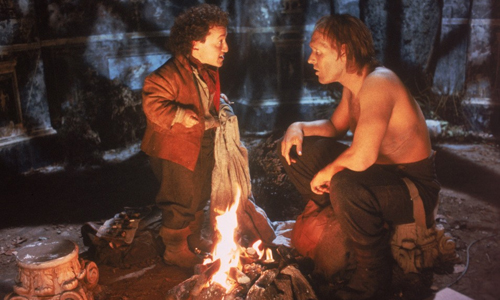The Bride (1985)

DIRECTOR: Franc Roddam
CAST: Sting, Jennifer Beals, Clancy Brown, David Rappaport, Geraldine Page, Anthony Higgins, Cary Elwes, Alexei Sayl, Phil Daniels
REVIEW:
A sort of re-imagining of James Whale’s 1930s classic Bride of Frankenstein, Franc Roddam’s The Bride might have confused audiences about what it was trying to be—-Gothic horror? Gothic romance?—-and largely fell through the cracks with a lackluster critical reception. That’s a bit of a shame, because for those who gives it a chance, The Bride is a handsomely-filmed, often atmospheric Gothic fairy tale.
We open, appropriately, on a dark and stormy night, where Baron Charles Frankenstein (Sting) is attempting to bring to life—-via a body constructed of sewn-together body parts from corpses and an electrical charge by conducting lightning—-a female mate (Jennifer Beals) for his previous effort, the hulking but slow-witted Viktor (Clancy Brown). But things go awry, leaving the tower destroyed, Viktor escaping into the forest and presumed dead, and Baron Frankenstein not taking long before he decides to make the most of the situation and take the woman, whom he dubs Eva, for himself, determining—-despite his obvious elitism and generally cold and haughty demeanor—-to “create the new woman”, an equal partner to a man. Meanwhile, Viktor befriends the dwarf trapeze artist Rinaldo (David Rappaport), and the pair join a traveling circus, but tragedy eventually strikes. At the same time, the more intelligent and independent-minded Eva becomes, the more frustrated she gets with Frankenstein’s restrictive and controlling treatment of her.
While this is an extremely loose “re-imagining” of Bride of Frankenstein, Franc Roddam and screenwriter Lloyd Fonvielle harken back to two aspects of Mary Shelly’s original Frankenstein story that are sometimes forgotten: the fact that it is Dr. Frankenstein himself, not his so-called monster, who is the story’s real “villain”, and Shelly’s bold feminism. While it’s technically classified as horror, The Bride is really more of a Gothic romance, handsomely-filmed by cinematographer Stephen H. Burum with lush, provincial location photography, sumptuous costumes, and grandly designed, detailed medieval castle sets, accompanied by a grandly sweeping score by veteran composer Maurice Jarre. The “on a dark and stormy night…” opening depicting Eva’s electric, fiery “birth” is suitably atmospheric, and later there’s a striking sequence in which an entire opulent party is doused in cascades of glitter raining from the ceiling, leaving everyone spending the rest of the night with brilliantly shimmering hair.

The Bride is essentially two movies wrapped into one, a buddy movie of sorts with Viktor and Rinaldo, and the increasingly toxic “romance” of Eva and Baron Frankenstein. The acting is strongest in the former, with Viktor and Rinaldo’s story being funny, touching, and ultimately tragic. Eva’s life—-riding horses, attending balls, learning classical literature—-might look more desirable than Viktor and Rinaldo’s as the odd couple scrounge by from village to hamlet, but the more self-aware she becomes, the more she feels locked in a gilded cage. While the two parallel tracks seem largely disconnected from each other for much of the runtime, it should come as no surprise to anyone that they eventually find their way onto a collision course.
The cast was a mixed bag. For two of his lead roles, Roddam cast Sting—-better-known as a singer than for his few acting roles—-and Flashdance’s Jennifer Beals. While Sting acquits himself surprisingly credibly as the cold, haughty Baron Frankenstein—-a role that doesn’t necessarily require a great deal of emotional range—-Beals doesn’t show much more acting ability than she did in Flashdance. Considering Eva has the fullest character arc of anyone in the movie—-evolving from a childlike innocent into a cultured, well-educated woman and in the process getting more frustrated and rebellious against Frankenstein’s controlling behavior—-Beals not being fully up to the task of conveying this partially weakens the movie. This is in contrast to character actor Clancy Brown, who—-despite being mostly unrecognizable under prosthetics and makeup—-brings out the humanity and childish innocence of Viktor. Sting and Beals might be top-billed and the movie’s biggest “stars”, but its real star is Brown, who also finds a solid “buddy movie”-style rapport with his co-star in his half of the story, David Rappaport. Other supporting performances are supplied by Geraldine Page as Frankenstein’s stern housekeeper, Anthony Higgins as his libertine friend Clerval, Cary Elwes (already oozing the smarmy charm he’d be known for) as a handsome young soldier who threatens to come between Eva and Frankenstein, and Alexei Sayl and Phil Daniels essentially providing secondary “villains” as the exploitative circus manager and his slimy right hand man. In small roles are brief opening appearances by Quentin Crisp and a young Timothy Spall (the latter essentially this movie’s version of Igor), and later German supermodel Veruschka von Lehndorff.
Despite being written and directed by men, The Bride harkens back to Mary Shelly’s feminism. Perhaps because of its uncertain genre placement, or not being “horror” enough for a Frankenstein story, it was never likely to capture the public or critics’ fancy, but it remains an underrated, overlooked and handsomely-crafted small gem.
* * *